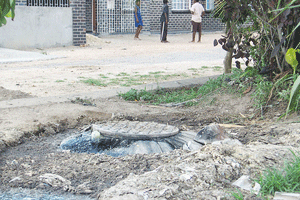
GIVEN a choice, no one in their right mind would subject themselves to breathing excretion-filled air, everyday.
Report by Chipo Masara

Unfortunately, most Zimbabweans do not have much of a choice in the matter. The sewer system has fallen apart, like all other service structures, following the decade-long economic meltdown.
The system is evidently old and bruised as the bulk of the sewer pipes in most old suburbs like Mbare and Highfield were installed way before the country’s independence in 1980.
The problem of burst sewer pipes has been exacerbated by the ever-growing urban population and persistent water cuts.
after the dollarisation of the economy, there has not been noticeable effort by the local authorities to repair or replace the collapsed system. They always blame it on “lack of funds”.
Meanwhile, with the rainy season fast approaching, people in most of the country’s urban areas are bracing themselves for the inevitable sewer pipe bursts and the resultant excretion overflows that would characterise their living environments.
Unfortunately, the majority of Zimbabwean urban dwellers are concentrated in high-density areas, which face the full brunt of the collapsed service system. A visit to areas such as Chitungwiza, Dzivaresekwa, Glen Norah, Glen View, Highfield, Mbare and Kuwadzana, especially during the rainy season, tends to be a highly unpleasant experience.
- Chamisa under fire over US$120K donation
- Mavhunga puts DeMbare into Chibuku quarterfinals
- Pension funds bet on Cabora Bassa oilfields
- Councils defy govt fire tender directive
Keep Reading
For residents of these suburbs, excretion flows have become part of everyday life.
If the raw sewage flows presented just the unbearable stench, maybe it would not be so worrying.
But with the faeces lying around comes the disease-carrying flies, popularly referred to as the “green bombers”.
These, coupled with those emanating from the dump sites that are common in almost every high-density suburb, present a very serious health challenge. Sadly, it is common to find barefoot children playing in the street, evidently unperturbed by the sewer flow, or the stench it produces.
Just this year, the country battled to contain a typhoid outbreak that had the Ministry of Health and Child Welfare in panic mode.
The outbreak, although at the moment under control, cannot be ruled out in the near future as the causes remain unattended.
Cholera has on a number of occasions also brought a fair share of misery to the country with about 4 000 people having succumbed to the 2008 outbreak.
An old and overburdened sewer system is however not only evident in Harare and surrounding areas, but has in fact plagued the whole country.
In Bulawayo, the situation is so bad the authorities have since issued residents a directive to join the so-called “big flush” exercise whereby all households would be required to flush their toilets simultaneously at 7:30pm every Monday and Thursday.
This move, they said, is designed to unblock sewers. The continually bursting sewer pipes make life a nightmare that many have had to live with for years on end.
While the responsible authorities keep blaming the persistent breakdown of service delivery on “lack of funds”, which has become pretty much a cliché, it does not look like relief will come for the many affected Zimbabweans anytime soon.
In the meantime, many continue to live with the stench, children get exposed to infections, and diseases such as typhoid and cholera remain very much a threat.
Authorities must react to sewage problems
It is about time that the authorities made the reconstruction of the country’s sewer system a priority in their budgets, if ever the homely feel and health of the majority is to be restored.
No one deserves to live in an excretion-filled environment, not even the poorest of us.











